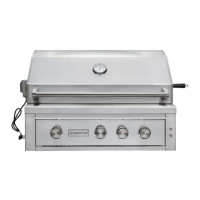3
Danger: If you smell gas:
• Shut o gas to the appliance.
• Extinguish any open ame.
• Open lid.
• If odor continues, keep away from the appliance and immediately call your gas
supplier or your re department.
Warning: Grills must have 24” clearance on all sides from combustible materials. If
installed in or near combustible fabrication materials, an insulated jacket MUST be used.
Warning:
• Do not store or use gasoline or other ammable liquids or vapors in the vicinity of this
or any other appliance.
• An LP cylinder not connected for use shall not be stored in the vicinity of this or any
other appliance.
!
!
!
Beware of Spiders!
Spiders and small insects occasionally spin webs or make nests in the burners during
warehousing, transit, and/or after a zlong period of not using the grill. These webs can
lead to a gas ow obstruction, which could result in a re in and around the burner
tubes. This type of re is known as “ashback” and can cause serious damage to your
grill and create an unsafe operating condition for the grill user. Although an obstructed
burner tube is not the only cause of “ashback,” it is the most common cause. Frequent
inspection of the burners is necessary.
Natural Gas Safety
• Natural gas grill (models GRL****NG) is designed to operate on natural gas only at a pressure
regulated at 4 inches water column (WC) when equipped with the correct natural gas orices on
the valves and a natural gas regulator on the supply line.
• Burners must be inspected and cleaned before each use.
• Never connect the grill to an unregulated natural gas supply.
• Check with your gas company or with local building codes for instructions on how to set up a
proper gas supply line.
• Use a licensed and knowledgeable installer to connect the gas lines to your grill.
• Pipe sealing compound or pipe thread tape that is suitable for use with natural gas must be used
on all male pipe thread. Apply compound or tape to at least the rst three threads when making the
connection.
• The grill must be isolated from the gas supply piping system by closing its individual manual
shuto valve during any pressure testing of the gas supply line at test pressures less than or equal
to ½ PSI (3.5 kPa).
• Turn o your gas grill when the gas supply is being tested at low pressures. This appliance must
be isolated from the gas supply piping system by closing its individual valve.
• Some states and municipalities have special licensing requirements for the handling of gas.
Reference the regulations of local authorities prior to installation.

